Centralized apps and decentralized apps (DApps) are two different types of applications with distinct advantages and disadvantages. Centralized apps are controlled by a single entity, while DApps are distributed across a network of computers. This difference in architecture leads to a number of key differences between the two types of apps.
What is Centralized Application?
A centralized application, or app, is a software program that is controlled by a single entity, such as a company or organization. This entity owns and operates the servers that the app runs on, and it has complete control over the app’s code and data.
Centralized apps are the most common type of app in use today. Some popular examples of centralized apps include social media platforms like Facebook and Twitter, messaging apps like WhatsApp and Telegram, and e-commerce platforms like Amazon and eBay.
Examples of Centralized Application
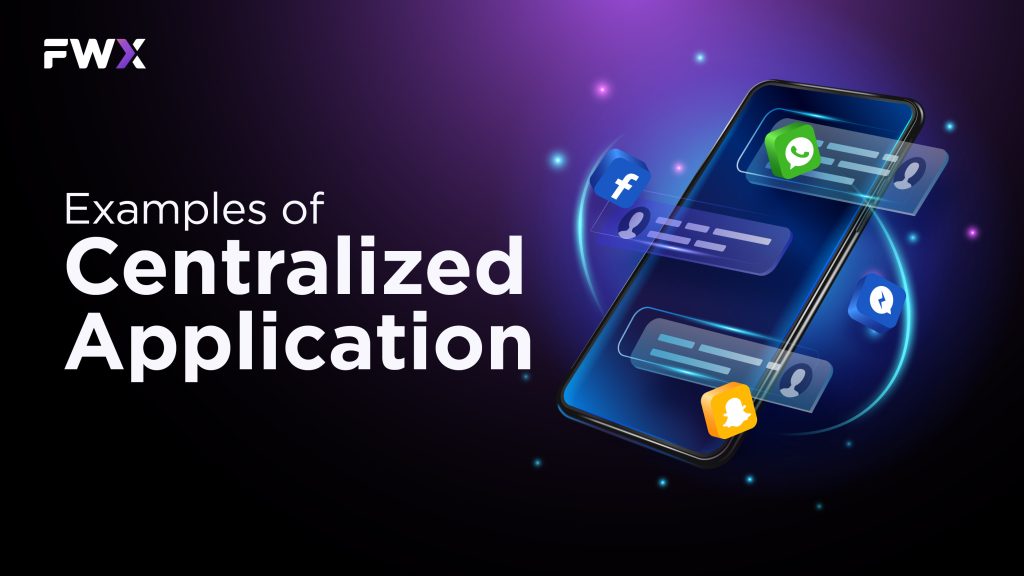
- Facebook: Facebook is one of the most well-known examples of a centralized application. All user data, posts, and interactions are stored and managed on Facebook’s servers. The company controls the platform and makes decisions regarding content moderation and privacy policies.
- Amazon: Amazon’s e-commerce platform is another example of a centralized application. All product listings, user accounts, and transactions are controlled by Amazon, and the company manages the entire shopping experience.
Advantages and disadvantages of Centralized Application
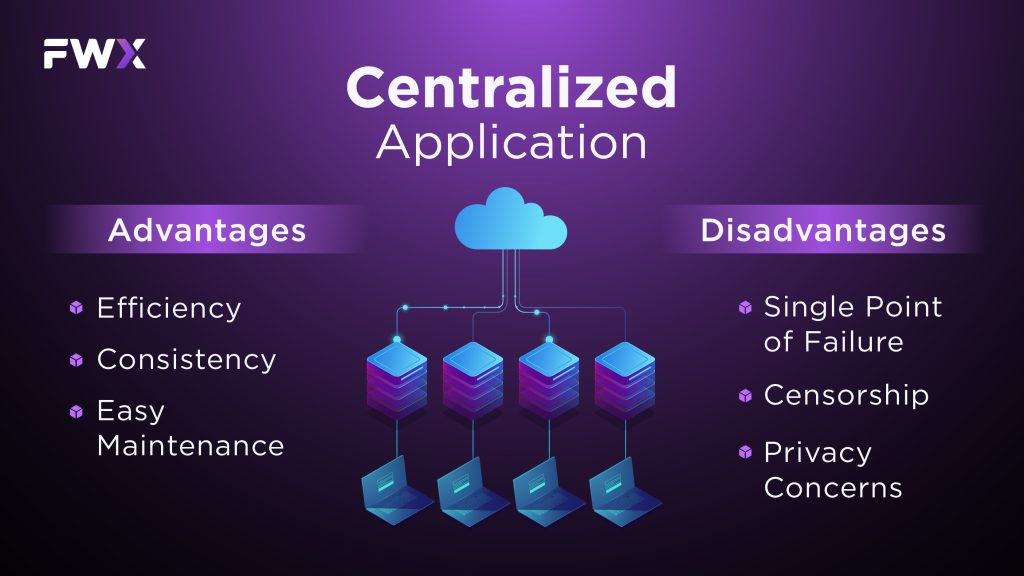
Centralized applications have a number of advantages, including:
- Efficiency: Centralized Apps are often more efficient and faster since they can use powerful server infrastructure.
- Consistency: Users experience a uniform interface and functionality across all devices and platforms.
- Easy Maintenance: Updates and maintenance can be centrally controlled and distributed.
However, centralized applications also have a number of disadvantages, including:
- Single Point of Failure: Centralized Apps are vulnerable to server outages, hacking, and data breaches.
- Censorship: The entity in control can censor or restrict content and features.
- Privacy Concerns: Users may have limited control over their data and privacy.
What is Decentralized Application (DApp)?
A Decentralized Application, or DApp, is a software application that operates on a decentralized network, typically using blockchain technology. In a DApp, data and processing are distributed across a peer-to-peer network, and no single entity has full control over the application. This decentralized nature offers transparency and security, making DApps popular in areas such as finance, gaming, and supply chain management.
Examples of Decentralized Application (DApp)
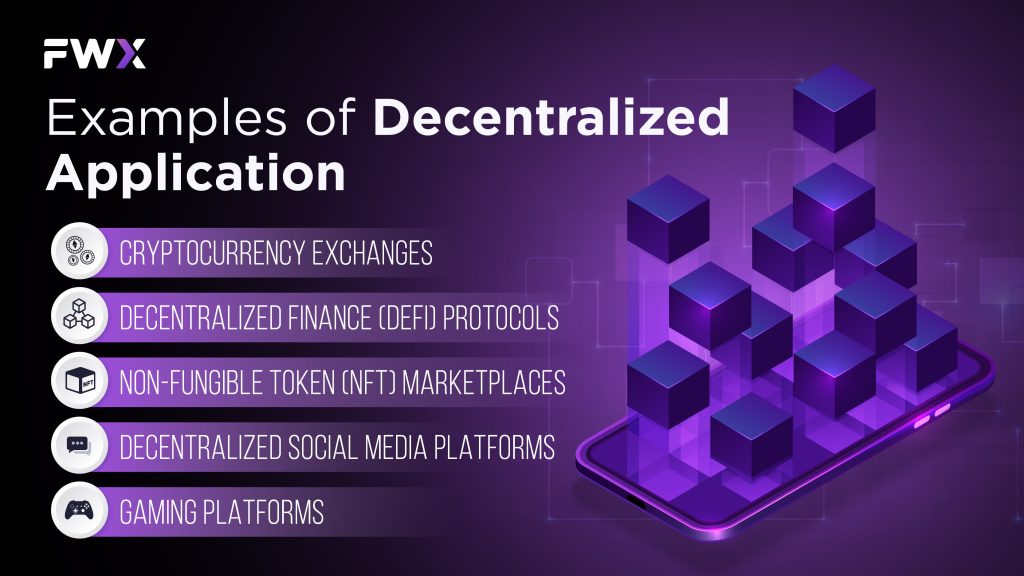
Some popular examples of DApps include:
- Cryptocurrency exchanges: DApps like Uniswap and Sushiswap allow users to trade cryptocurrencies without the need for a centralized intermediary.
- Decentralized finance (DeFi) protocols: DApps like Aave and Compound allow users to borrow and lend cryptocurrencies without the need for a bank or other traditional financial institution.
- Non-fungible token (NFT) marketplaces: DApps like OpenSea and Rarible allow users to buy, sell, and trade NFTs.
- Decentralized social media platforms: DApps like Mastodon and Nostr allow users to connect with each other without the need for a centralized platform like Facebook or Twitter.
- Gaming platforms: DApps like Axie Infinity and The Sandbox allow users to play.
Advantages and disadvantages of Decentralized Application (DApp)
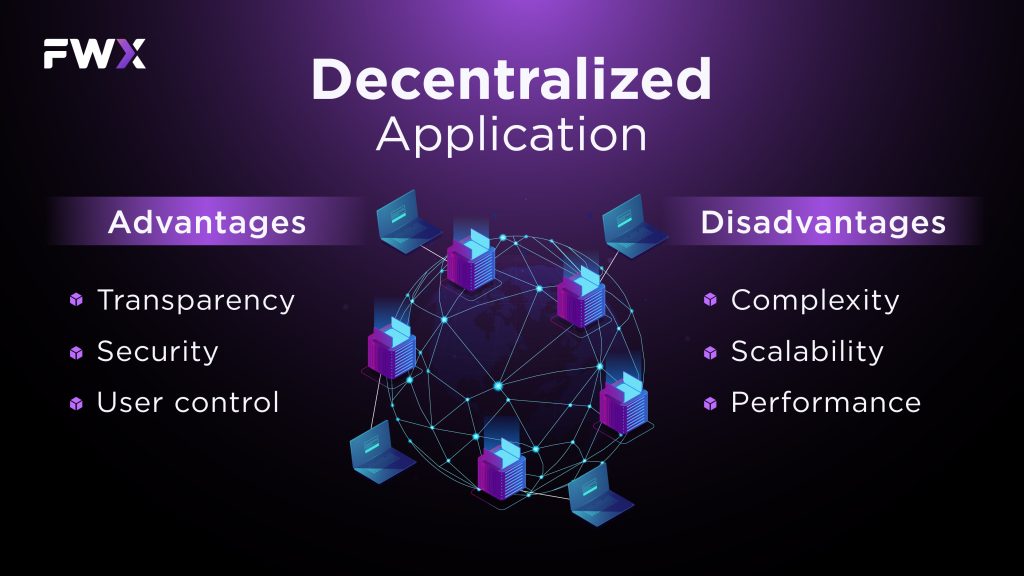
Decentralized applications have a number of advantages, including:
- Transparency: DApps are more transparent than centralized apps. This is because all transactions and data on a DApp are stored on the blockchain, which is a public ledger.
- Security: DApps are more secure than centralized apps. This is because they are not reliant on a single server, and they are difficult to hack or censor.
- User control: Users of DApps have more control over their data and the app itself. This is because DApps are governed by smart contracts, which are immutable and transparent.
However, decentralized applications also have a number of disadvantages, including:
- Complexity: DApps can be more complex to use than centralized apps. This is because users need to understand how blockchain works in order to use DApps effectively.
- Scalability: DApps are less scalable than centralized apps. This is because they are limited by the processing power of the blockchain network.
- Performance: DApps can be slower than centralized apps. This is because they need to verify all transactions on the blockchain before they can be executed.
The difference between Centralized App and DApp
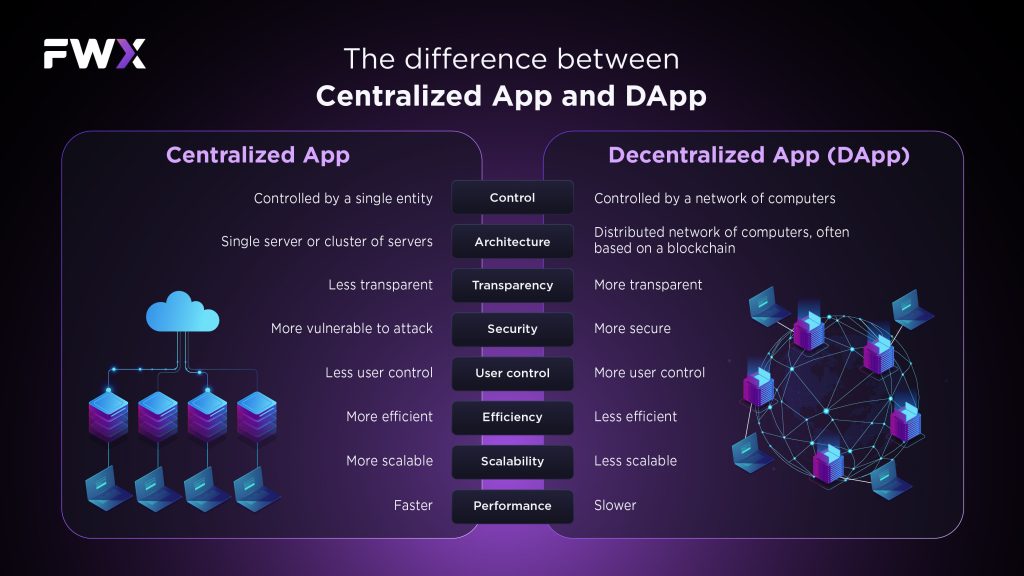
The key difference between a centralized app and a decentralized app (DApp) is the architecture on which they are built. Centralized apps are controlled by a single entity, such as a company or organization. DApps, on the other hand, are distributed across a network of computers, often based on a blockchain.
| Characteristic | Centralized App | Decentralized App (DApp) |
| Control | Controlled by a single entity | Controlled by a network of computers |
| Architecture | Single server or cluster of servers | Distributed network of computers, often based on a blockchain |
| Transparency | Less transparent | More transparent |
| Security | More vulnerable to attack | More secure |
| User control | Less user control | More user control |
| Efficiency | More efficient | Less efficient |
| Scalability | More scalable | Less scalable |
| Performance | Faster | Slower |
How to build Centralized App and DApp
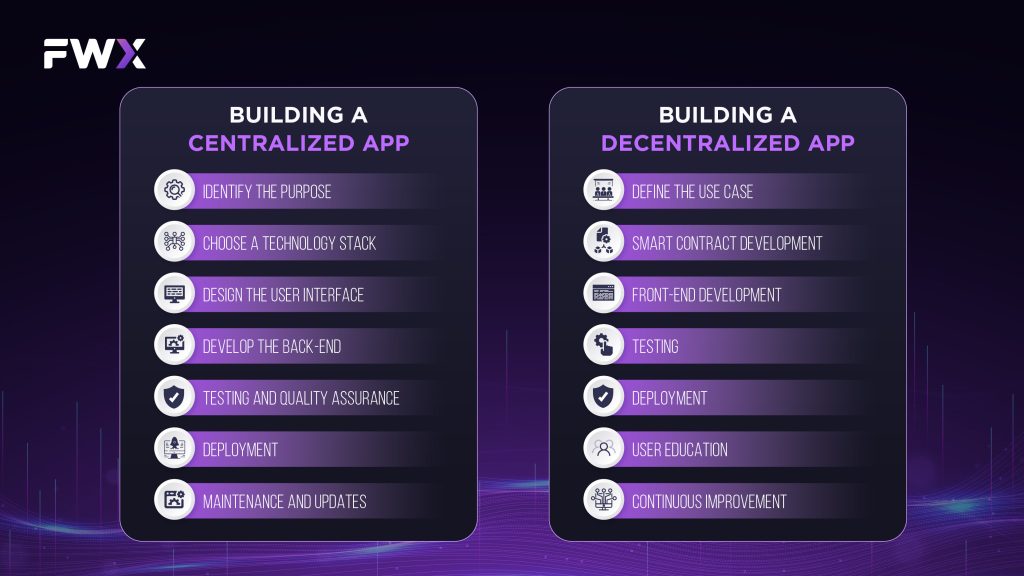
Building a Centralized App:
- Identify the Purpose: Define the purpose and features of your app.
- Choose a Technology Stack: Select the appropriate programming languages, frameworks, and tools.
- Design the User Interface: Create the app’s user interface and user experience.
- Develop the Back-End: Build the server and database components.
- Testing and Quality Assurance: Test the app thoroughly to identify and fix issues.
- Deployment: Deploy the app on a web server or a cloud platform.
- Maintenance and Updates: Continuously monitor and improve your app.
Building a DApp:
- Define the Use Case: Clearly define the use case for your DApp and identify the blockchain platform to use.
- Smart Contract Development: Create smart contracts that define the logic of your DApp.
- Front-End Development: Build the user interface that interacts with the smart contracts.
- Testing: Test your DApp on a blockchain testnet to ensure its functionality and security.
- Deployment: Deploy the DApp on the chosen blockchain network.
- User Education: Educate users on how to interact with your DApp and manage their private keys.
- Continuous Improvement: Regularly update and maintain your DApp to enhance its features and security.
In conclusion, Centralized App vs DApp: Centralized Apps and DApps have distinct characteristics, advantages, and disadvantages. The choice between them depends on the specific requirements of your project and your commitment to central control, security, and transparency. Whether you opt for a Centralized App or a DApp, understanding the nuances of each approach is crucial for success in the ever-evolving world of software development.


